Nelson County
Long Time Gone
27/03/25 07:32
The Quarry Gardens at Schuyler
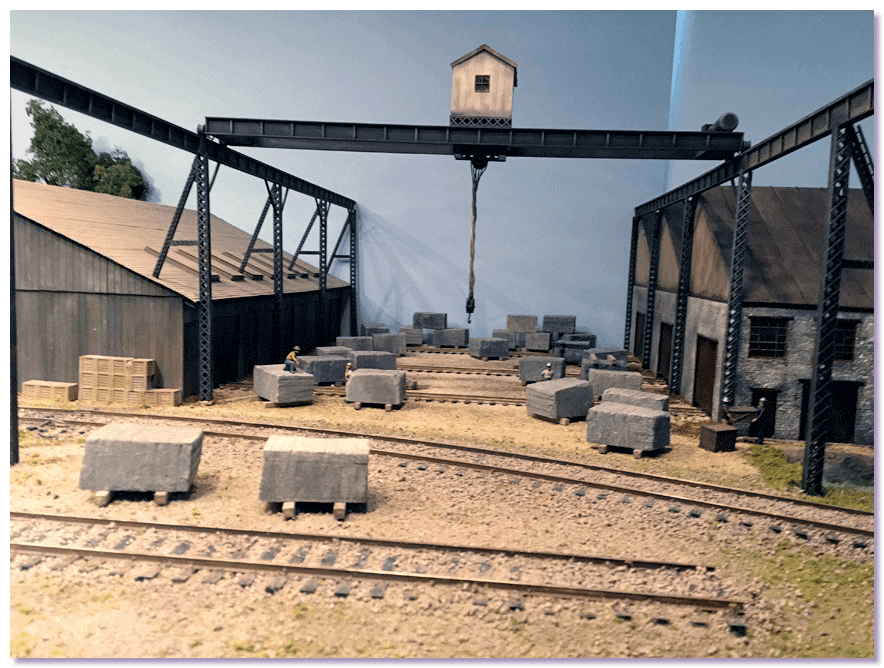
The stone yard in the Mill shadowbox
Many years ago I was involved in the development and construction of an O scale 2 rail display at the Quarry Gardens at Schuyler. The railroad display depicts the Nelson & Albemarle Railroad, which served the quarry operations in the immediate vicinity of the Gardens. The original plan was for the display to include Rockfish Depot, the mill at Schuyler, a soapstone quarry near Alberene, and Esmont shadowboxes.
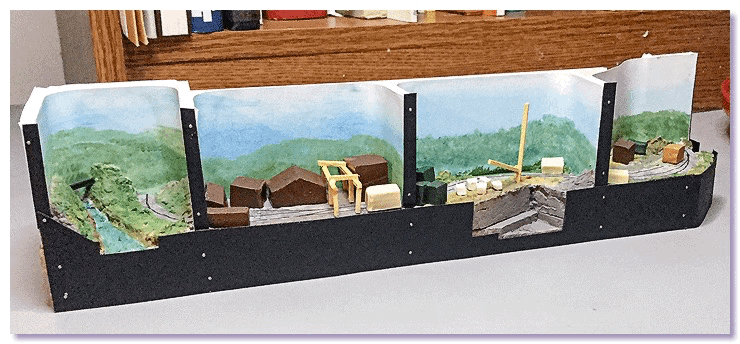
Original concept for a very large railroad display
A few years into the project Rail Tales of Charlottesville took over construction of the railroad display. I had urgent aging parent issues to deal with at that time which forced me to resign my duties at the Quarry Gardens. After my exit the decision was made to reduce the number of shadowboxes in the railroad display from four to two.
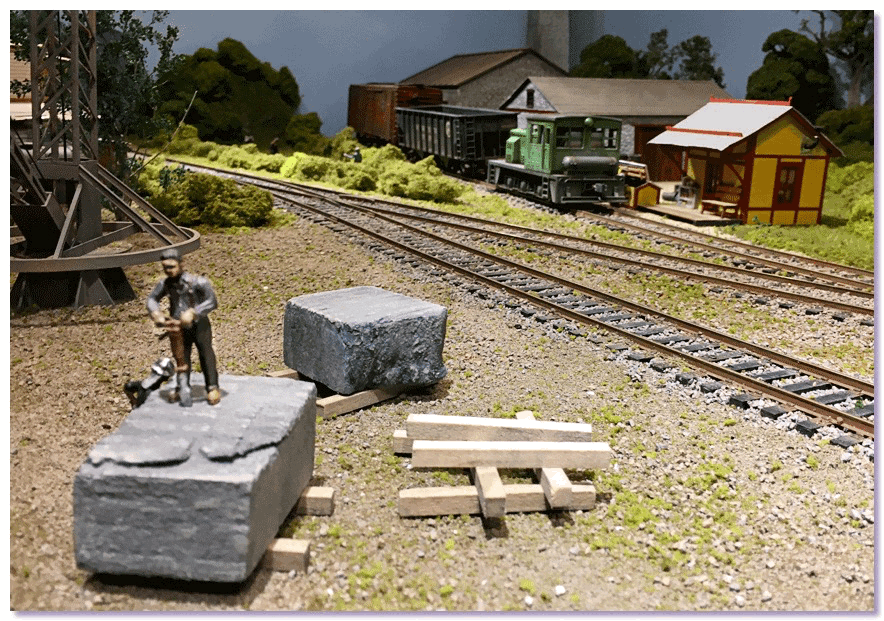
Rail Tales did an excellent job completing the construction of the railroad display. It is an interesting and attractive representation of local history.
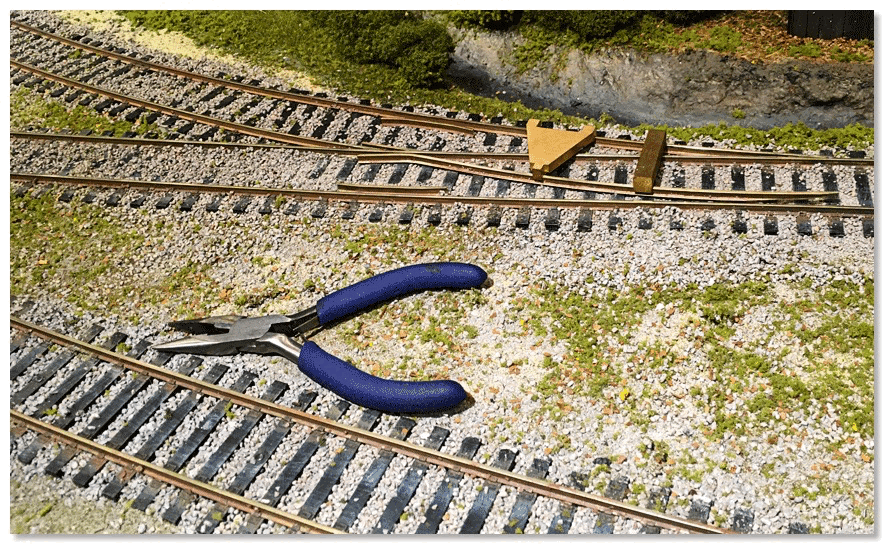
As family issues have been resolved I was able to re-establish contact with the Quarry Gardens. I am working on the railroad display once again, doing the kind of maintenance and upgrades that a working model railroad requires.
The Smoking Gun
16/03/24 08:11
The beginning of this saga can be found here.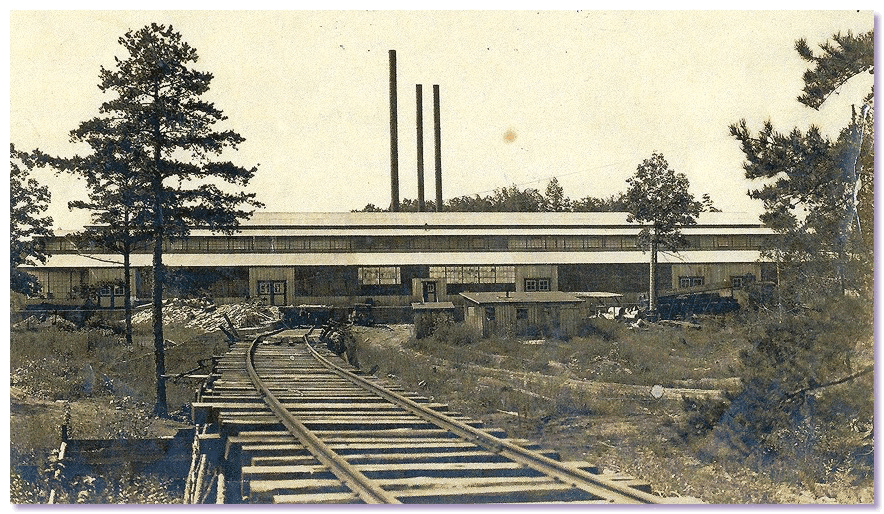 Standard gauge tracks at the Standard Soapstone plant near Phoenix in Nelson County
Standard gauge tracks at the Standard Soapstone plant near Phoenix in Nelson County
My tour of the Phoenix area with Jim, along with the old photographs he sent me from his collection, certainly verified the existence of a narrow gauge industrial railroad initially serving Phoenix Stone then Standard Soapstone. In Hearbeats of Nelson, Paul Saunders had interviewed Phoenix residents who had worked as railroad laborers laying dual gauge track.
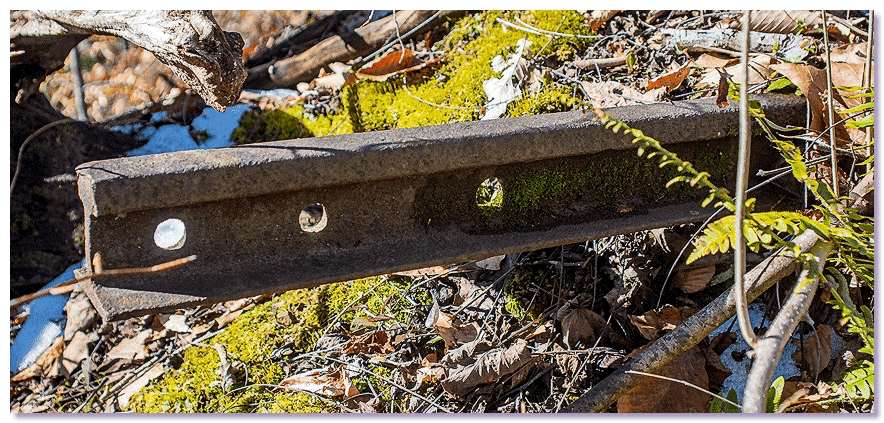
Worn scrap of light rail at an abandoned Phoenix soapstone quarry site
But I had yet to see a photograph that showed narrow gauge track beside standard gauge track in a straight forward manner that would put the entire matter to rest. And so it was to remain for years. Subsequent visits to Phoenix turned up shallow cuts and fills that may well have been part of the narrow gauge right-of-way, as well as railroad track hardware near the abandoned quarry sites.
Immediately after the Pandemic I paid a visit to Garth Groff, author of the Soapstone Shortlines book. We discussed my efforts to uncover evidence of a narrow gauge soapstone railroad. Afterwards Garth sent me exactly what I was looking for.
The Southern Railway Historical Society had published an article by E.R. Conner, III about Arrington, Virginia. Conner's article mentioned the Southern's dealings with Phoenix Stone's narrow gauge railroad. It also included the photo I had wanted to see for so long.
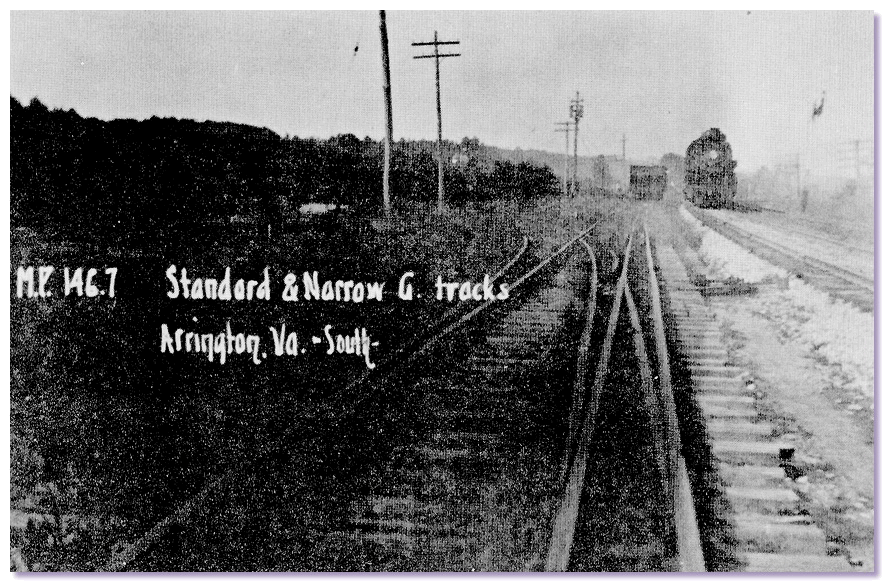
The Southern mainline is to the right, dual gauge in the center, narrow gauge track diverging off to the left

A track diagrm showing narrow gauge tracks
Garth supplied the evidence needed for me to consider this case closed. As an added bonus, he sent along a photo of a standard gauge Standard Soapstone locomotive.
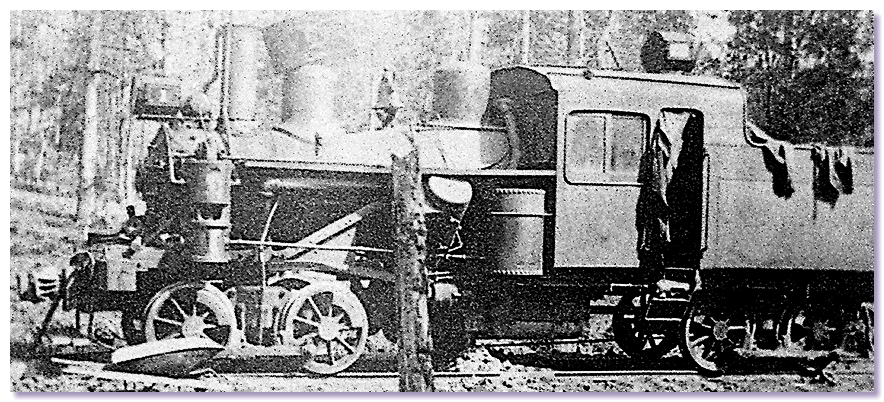
Standard gauge locomotive at the Standard Soapstone plant
This Heisler was the only steam locomotive owned by any soapstone railroad that was not a saddle tanker. Or was it? That is an investigation for another time.
More facts come to light.
 Standard gauge tracks at the Standard Soapstone plant near Phoenix in Nelson County
Standard gauge tracks at the Standard Soapstone plant near Phoenix in Nelson CountyMy tour of the Phoenix area with Jim, along with the old photographs he sent me from his collection, certainly verified the existence of a narrow gauge industrial railroad initially serving Phoenix Stone then Standard Soapstone. In Hearbeats of Nelson, Paul Saunders had interviewed Phoenix residents who had worked as railroad laborers laying dual gauge track.

Worn scrap of light rail at an abandoned Phoenix soapstone quarry site
But I had yet to see a photograph that showed narrow gauge track beside standard gauge track in a straight forward manner that would put the entire matter to rest. And so it was to remain for years. Subsequent visits to Phoenix turned up shallow cuts and fills that may well have been part of the narrow gauge right-of-way, as well as railroad track hardware near the abandoned quarry sites.
Immediately after the Pandemic I paid a visit to Garth Groff, author of the Soapstone Shortlines book. We discussed my efforts to uncover evidence of a narrow gauge soapstone railroad. Afterwards Garth sent me exactly what I was looking for.
The Southern Railway Historical Society had published an article by E.R. Conner, III about Arrington, Virginia. Conner's article mentioned the Southern's dealings with Phoenix Stone's narrow gauge railroad. It also included the photo I had wanted to see for so long.

The Southern mainline is to the right, dual gauge in the center, narrow gauge track diverging off to the left

A track diagrm showing narrow gauge tracks
Garth supplied the evidence needed for me to consider this case closed. As an added bonus, he sent along a photo of a standard gauge Standard Soapstone locomotive.

Standard gauge locomotive at the Standard Soapstone plant
This Heisler was the only steam locomotive owned by any soapstone railroad that was not a saddle tanker. Or was it? That is an investigation for another time.
Rampant Speculation
04/02/24 20:53
The beginning of this saga can be found here.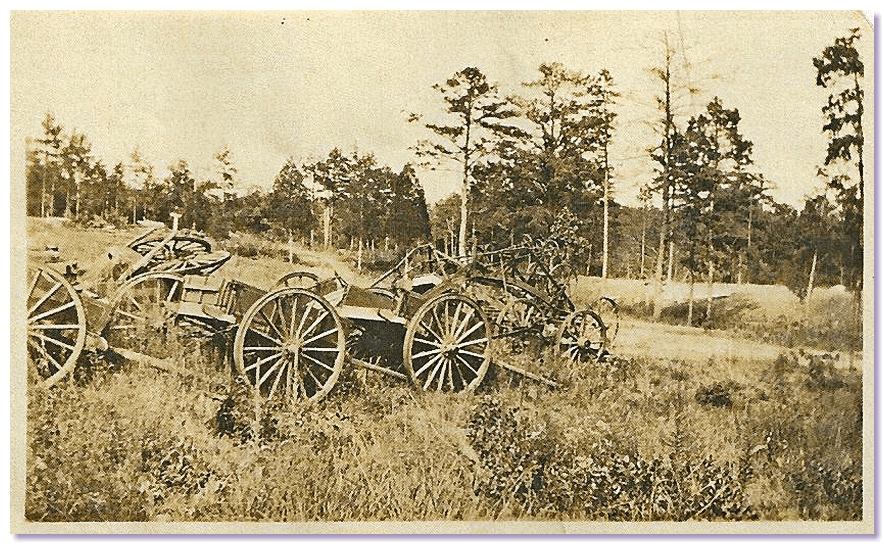
The wagons in this picture probably have been gathered and piled to be photographed for an auction catalog. It immediately brings to mind one of Jim's stories about how Phoenix soapstone would haul wagon loads of laundry sinks to the Southern Railroad's depot at Arrington.
These aren't wagons but carts, probably used for road grading. The soapstone company apparently graded and maintained the local roads using these horse drawn carts. This implies that the soapstone company was using horses, trucks, steam tractors, and trains all at the same time.
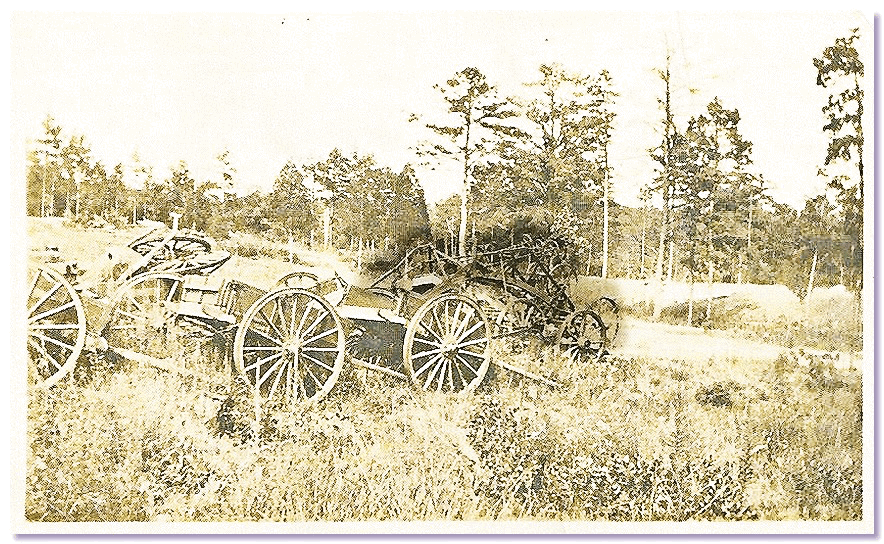
Buried in the pile of carts is a road grader which I have emphasized in this copy of the photo.
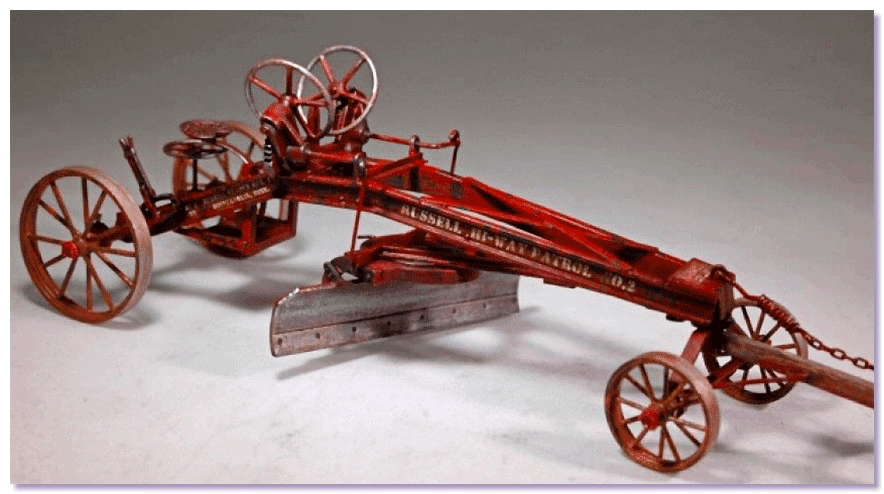
The road grader bears a strong resemblance to the O scale Russell road grader available from Wiseman Modeling Services. The grader may have been used with the carts, and was also horsedrawn.
Broken and flawed soapstone coming out of the quarries may have provided plenty of raw material for road building aggregate, but it would have to be crushed.
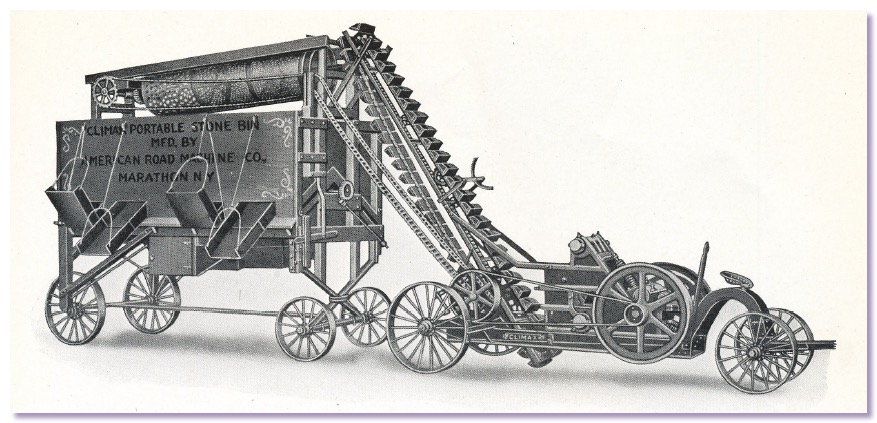
Back in the 1920s, road construction trade magazines contain ads for portable crusher/spreader outfits. Had Phoenix soapstone bought one of these contraptions?
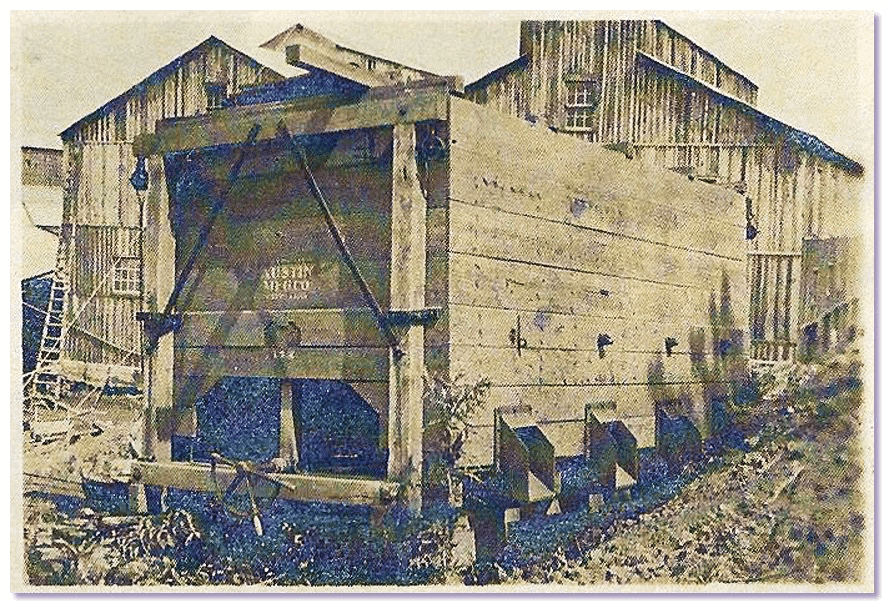
Apparently so. Here is another of Jim's old photos of items to be auctioned. This v-bottom side dump gravel hauler was most likely delivered with a crusher and bucket belt to lift the gravel into the box. Where did the crusher and bucket belt end up?
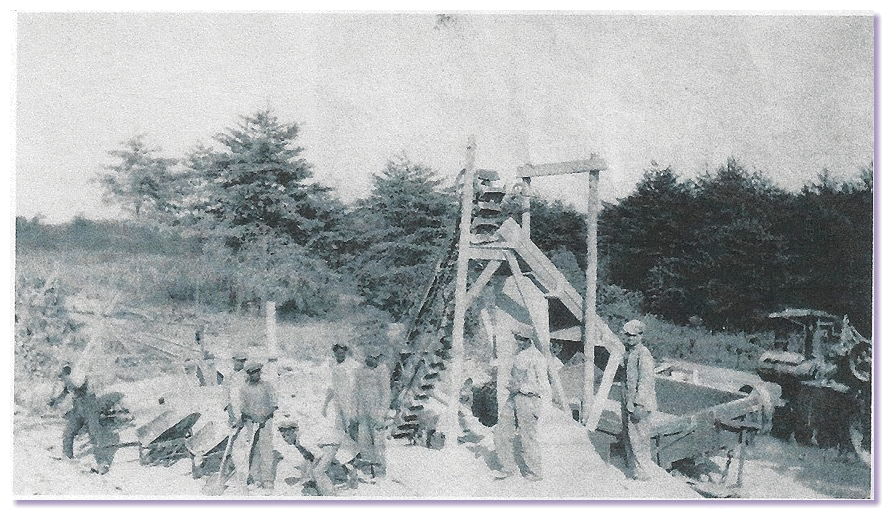
At the talc loader, of course.
Here is another photo Jim sent me.

The wagons in this picture probably have been gathered and piled to be photographed for an auction catalog. It immediately brings to mind one of Jim's stories about how Phoenix soapstone would haul wagon loads of laundry sinks to the Southern Railroad's depot at Arrington.
These aren't wagons but carts, probably used for road grading. The soapstone company apparently graded and maintained the local roads using these horse drawn carts. This implies that the soapstone company was using horses, trucks, steam tractors, and trains all at the same time.

Buried in the pile of carts is a road grader which I have emphasized in this copy of the photo.

The road grader bears a strong resemblance to the O scale Russell road grader available from Wiseman Modeling Services. The grader may have been used with the carts, and was also horsedrawn.
Broken and flawed soapstone coming out of the quarries may have provided plenty of raw material for road building aggregate, but it would have to be crushed.

Back in the 1920s, road construction trade magazines contain ads for portable crusher/spreader outfits. Had Phoenix soapstone bought one of these contraptions?

Apparently so. Here is another of Jim's old photos of items to be auctioned. This v-bottom side dump gravel hauler was most likely delivered with a crusher and bucket belt to lift the gravel into the box. Where did the crusher and bucket belt end up?

At the talc loader, of course.
What's Going On Here?
20/01/24 13:46
The beginning of this saga can be found here.

This photo appears in Paul Saunders' book Heartbeats of Nelson. It was taken at the Phoenix Soapstone operation. The caption identifies it as soapstone workers.
Soapstone operations in Nelson County involved cutting big blocks of stone out of quarries. It is obvious that the men in the photo are not engaged in that type of activity. They appear to be shoveling light colored dirt or sand into wheelbarrows. I believe they are working a talc deposit. Soapstone being composed primarily of talc, it would seem probable that there could be an outcropping of the mineral talc itself near the soapstone deposits. Talc is very soft and flaky, light colored with a silvery luster. Handling it leaves a glittery residue on everything it touches. There were a wide range of industrial applications for talc, making it worthwhile to extract and ship.
The men with the shovels and wheelbarrows are providing the extraction. A side dump car to the right in the photo appears to be providing the means for shipping the talc. It does not appear that the workers are dumping wheelbarrows of talc directly into the side dump car. The talc is being dumped into the car after being lifted unnecessarily high in the air with a bucket belt. The lower end of the bucket belt would probably be catching the talc after it had been milled in a crusher.
Near left center there is a vertical pole or pipe that could well be an exhaust pipe for either an internal combustion or steam engine that would drive the crusher and bucket belt. I suspect it is a steam engine because a small diameter steam line is entering the photo from the left, running toward the base of the pipe. Simple "X" shaped supports are supporting the steam line.
A steam tractor is visible just down the hillside below the side dump car. I imagine that tractor might have been used as a locomotive to get the side dump car to the talc site. It all adds up to what would be a great little scene to model, requiring a lot of research and creative solutions to represent what is not visible in the photo.
One of the old photos Jim scanned for me I found particularly interesting.

This photo appears in Paul Saunders' book Heartbeats of Nelson. It was taken at the Phoenix Soapstone operation. The caption identifies it as soapstone workers.
Soapstone operations in Nelson County involved cutting big blocks of stone out of quarries. It is obvious that the men in the photo are not engaged in that type of activity. They appear to be shoveling light colored dirt or sand into wheelbarrows. I believe they are working a talc deposit. Soapstone being composed primarily of talc, it would seem probable that there could be an outcropping of the mineral talc itself near the soapstone deposits. Talc is very soft and flaky, light colored with a silvery luster. Handling it leaves a glittery residue on everything it touches. There were a wide range of industrial applications for talc, making it worthwhile to extract and ship.
The men with the shovels and wheelbarrows are providing the extraction. A side dump car to the right in the photo appears to be providing the means for shipping the talc. It does not appear that the workers are dumping wheelbarrows of talc directly into the side dump car. The talc is being dumped into the car after being lifted unnecessarily high in the air with a bucket belt. The lower end of the bucket belt would probably be catching the talc after it had been milled in a crusher.
Near left center there is a vertical pole or pipe that could well be an exhaust pipe for either an internal combustion or steam engine that would drive the crusher and bucket belt. I suspect it is a steam engine because a small diameter steam line is entering the photo from the left, running toward the base of the pipe. Simple "X" shaped supports are supporting the steam line.
A steam tractor is visible just down the hillside below the side dump car. I imagine that tractor might have been used as a locomotive to get the side dump car to the talc site. It all adds up to what would be a great little scene to model, requiring a lot of research and creative solutions to represent what is not visible in the photo.
Narrow Gauge in the Details
05/12/23 07:47
The beginning of this saga can be found here.
While narrow gauge equipment was not mentioned in the auction information, careful examination of the photos Jim had of the Standard Soapstone inventory indicated it was at the site at the time the operation shut down.
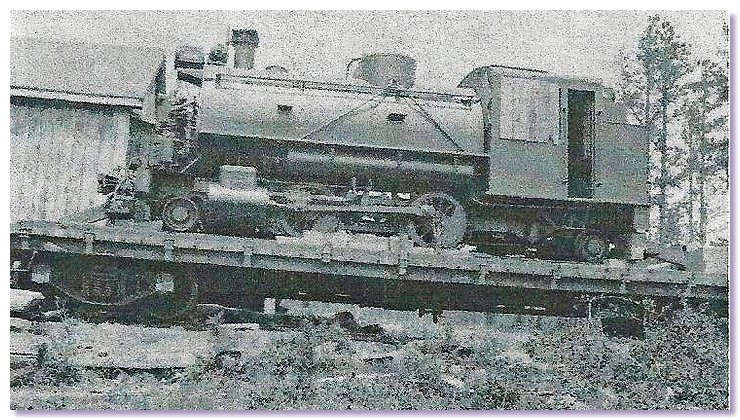
The air pumps and Jenny couplers on this saddletank locomotive indicate it is standard gauge.
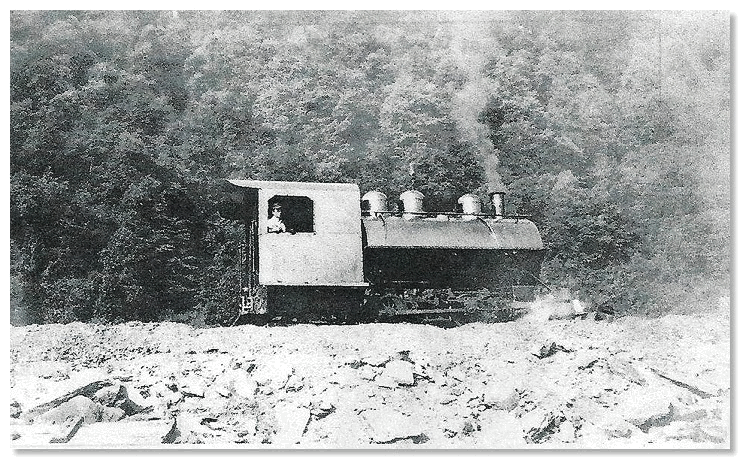
Lack of air pumps and couplers on this locomotive lead me to believe it is narrow gauge.
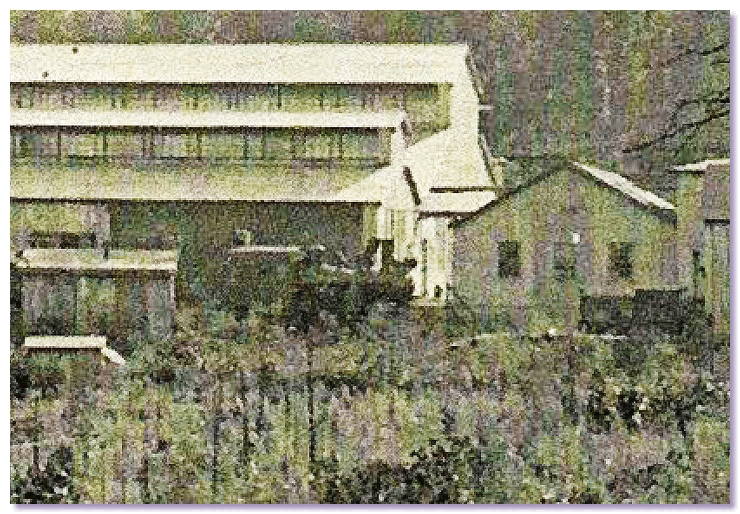
An enlarged detail of a photo of the Standard Soapstone mill after closure shows locomotives sitting in the weeds. One is a standard gauge Heisler. The boxy dark object to its right might be a Plymouth DL gas mechanical locomotive. If so, it was narrow gauge when sold to Alberene Soapstone in Schuyler where it was regauged to standard gauge.
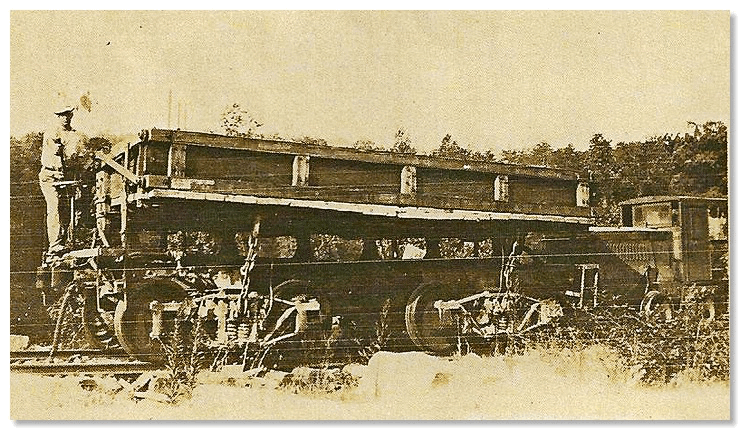
This photo may also show the narrow gauge Plymouth DL. The coupler and air line on the side dump car indicate it is standard gauge, so the Plymouth might in on a parallel narrow gauge track behind the dump car.
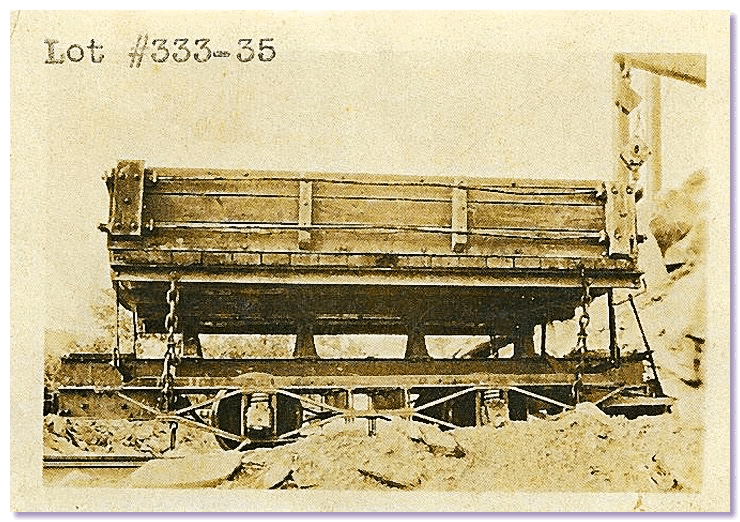
Jim had photos of various side dump cars that appear to be narrow gauge.
While narrow gauge equipment was not mentioned in the auction information, careful examination of the photos Jim had of the Standard Soapstone inventory indicated it was at the site at the time the operation shut down.

The air pumps and Jenny couplers on this saddletank locomotive indicate it is standard gauge.

Lack of air pumps and couplers on this locomotive lead me to believe it is narrow gauge.

An enlarged detail of a photo of the Standard Soapstone mill after closure shows locomotives sitting in the weeds. One is a standard gauge Heisler. The boxy dark object to its right might be a Plymouth DL gas mechanical locomotive. If so, it was narrow gauge when sold to Alberene Soapstone in Schuyler where it was regauged to standard gauge.

This photo may also show the narrow gauge Plymouth DL. The coupler and air line on the side dump car indicate it is standard gauge, so the Plymouth might in on a parallel narrow gauge track behind the dump car.

Jim had photos of various side dump cars that appear to be narrow gauge.
Photographic Evidence
07/11/23 06:05
The beginning of this saga can be found here.
We got the ATV back on the trailer and got in the truck out of the howling wind. Jim mentioned we were parked beside the main office building of Phoenix Stone.
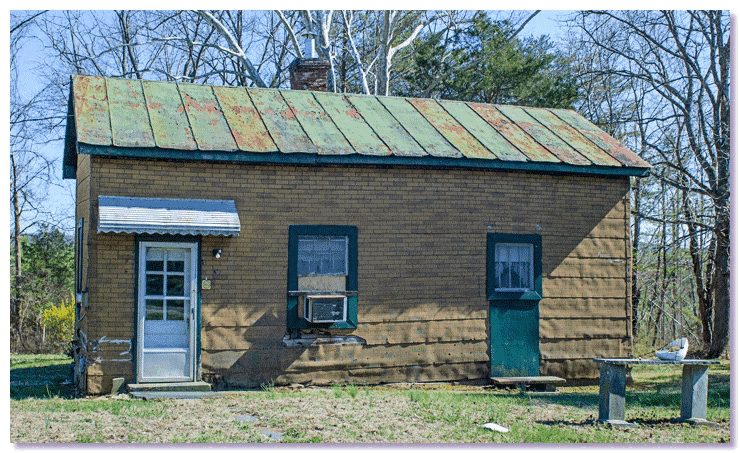
Phoenix Stone Company offices. Paymaster window to the right.
Jim pulled out a big binder of old photographs. Most were family pictures, but there were a few shots of the old soapstone operation and the railroad. I tried hard to commit the details to memory, scribbling notes about what Jim had told me and the subject matter in his photos.
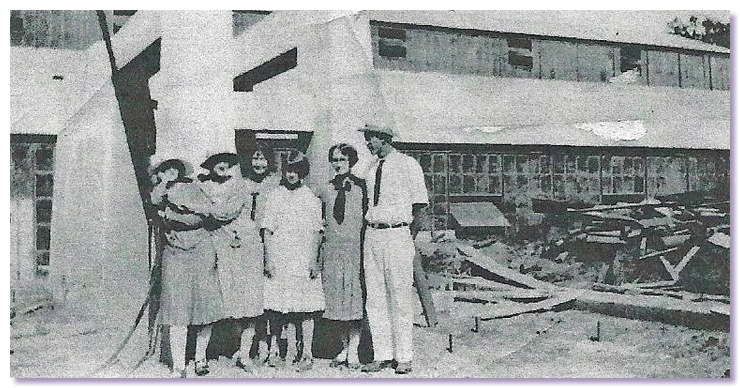
Group photo takwn at the boiler house site that I photographed about 80 years later.
A week or so later I started getting emailed image files from Jim. He was scanning pages of his photo album and sending them to me.
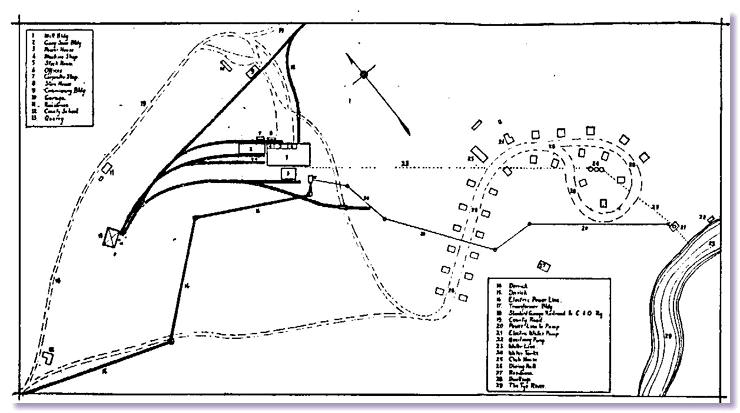
Overall layout of the Standard mill and company town. All railroad grades shown were standard gauge.
The vast majority of soapstone photos were taken after the operation was shut down. The photos were used to illustrate a catalog of items to be auctioned.
None of the auction material mentioned the narrow gauge.
We got the ATV back on the trailer and got in the truck out of the howling wind. Jim mentioned we were parked beside the main office building of Phoenix Stone.

Phoenix Stone Company offices. Paymaster window to the right.
Jim pulled out a big binder of old photographs. Most were family pictures, but there were a few shots of the old soapstone operation and the railroad. I tried hard to commit the details to memory, scribbling notes about what Jim had told me and the subject matter in his photos.

Group photo takwn at the boiler house site that I photographed about 80 years later.
A week or so later I started getting emailed image files from Jim. He was scanning pages of his photo album and sending them to me.

Overall layout of the Standard mill and company town. All railroad grades shown were standard gauge.
The vast majority of soapstone photos were taken after the operation was shut down. The photos were used to illustrate a catalog of items to be auctioned.
None of the auction material mentioned the narrow gauge.
Too good to be true?
17/10/23 06:10
The beginning of this saga can be found here.
Even though Phoenix had shut down over 10 years before he was born, Jim had grown up hearing about the operation. He was very specific about the details of the narrow gauge, the remains of which were much more evident when he was young.
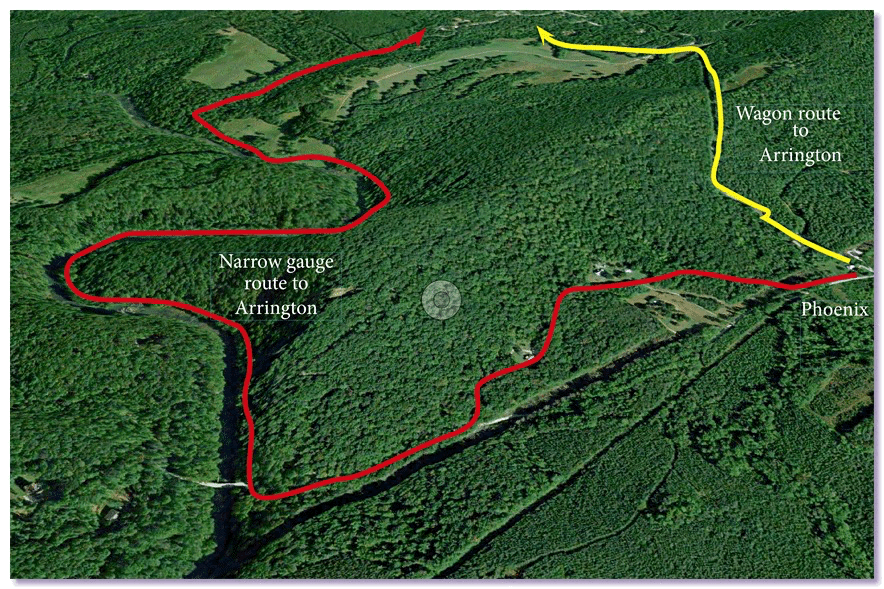
Jim said all of the narrow gauge grade he remembered ran immediately adjacent to dirt roads. Along the Tye River the track was on the river side, the road was on the hill side. There the road had been used by trucks to access a gravel pit.
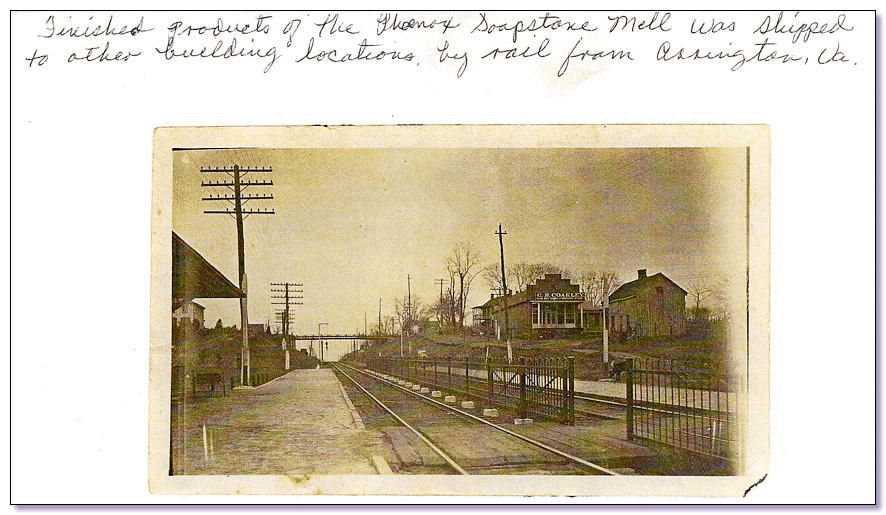
Before the narrow gauge, products from Phoenix Stone were hauled to Arrington by wagon. The wagon road still exists as State Route 661. In all the places around Phoenix that we visited that cold February day, I never noticed any indication of the old narrow gauge grade. Jim told me where it had been, but I saw no sign of it anywhere.
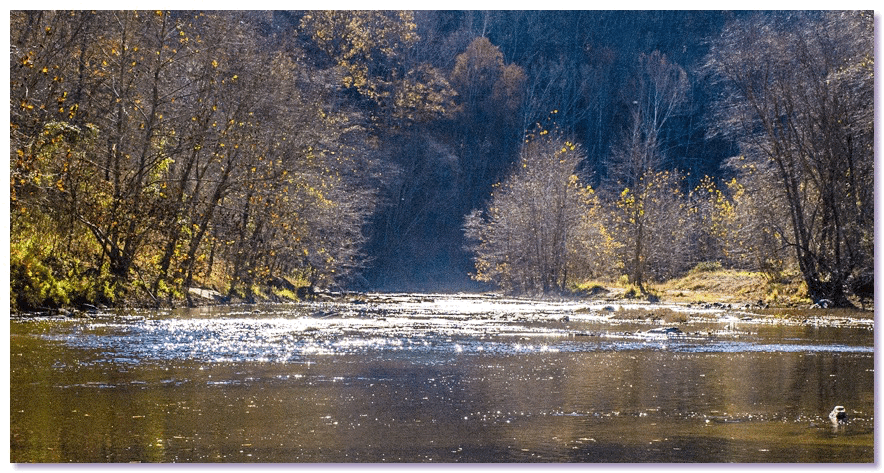
High on bluffs above the Tye River, the ruins of the Phoenix Stone Company — the mill, the quarries, the boilerhouses, the company houses — were very small. That such a small company had built a “sprawling” narrow gauge that ran miles along the river to reach a transfer point with a standard gauge railroad struck me as far fetched. But I let Jim talk, because he was saying exactly what I wanted to hear. He was describing my On30 layout to me.
Even though Phoenix had shut down over 10 years before he was born, Jim had grown up hearing about the operation. He was very specific about the details of the narrow gauge, the remains of which were much more evident when he was young.

Jim said all of the narrow gauge grade he remembered ran immediately adjacent to dirt roads. Along the Tye River the track was on the river side, the road was on the hill side. There the road had been used by trucks to access a gravel pit.

Before the narrow gauge, products from Phoenix Stone were hauled to Arrington by wagon. The wagon road still exists as State Route 661. In all the places around Phoenix that we visited that cold February day, I never noticed any indication of the old narrow gauge grade. Jim told me where it had been, but I saw no sign of it anywhere.

High on bluffs above the Tye River, the ruins of the Phoenix Stone Company — the mill, the quarries, the boilerhouses, the company houses — were very small. That such a small company had built a “sprawling” narrow gauge that ran miles along the river to reach a transfer point with a standard gauge railroad struck me as far fetched. But I let Jim talk, because he was saying exactly what I wanted to hear. He was describing my On30 layout to me.
A Guided Tour
19/09/23 13:50
The beginning of this saga can be found here.

A native of an old soapstone company town found my website
It happened that one day a guy named Jim saw my website and contacted me. We started emailing back and forth about soapstone history. Turns out Jim is from Nelson County, and his family worked for Phoenix Stone. He goes back to Phoenix occasionally to maintain a few family cemeteries. Jim offered to give me a tour of the Phoenix area.

Unloading the ATV on a frigid day
The day we picked to get together turned out to be windy and super cold. Jim brought his ATV for us to ride so we wouldn’t have to walk all over creation. As we were preparing to head out, Jim threw a pistol and a set of bolt cutters in the back of the ATV. “I know the kind of people we might run into.”
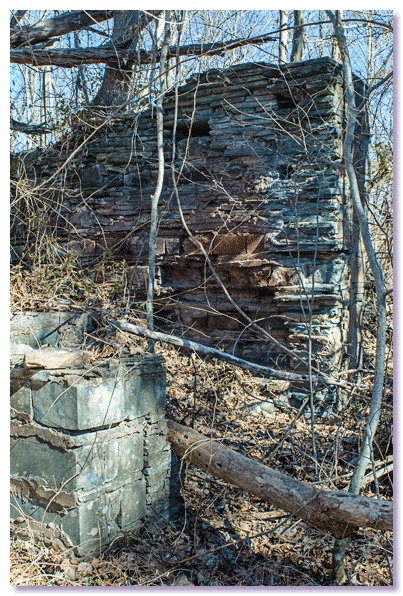
Ruins of the Phoenix mill and plant
Jim took me all through the woods, through people’s yards, across posted private property. We went all over the place. We saw the ruins of the “old” Phoenix Mill, the Virginia-Chesapeake Soapstone Co. quarry site, old company houses, old family cemeteries, and a talc quarry.

Phoenix Stone company house
I asked Jim if there had been a narrow gauge railroad at Phoenix Stone. He said yes. A 42 inch gauge railroad had run from the old mill site to the Virginia-Chesapeake quarry. It ran past the site of the old commisary, down past a row of company houses, along a creek to the Tye River, and all the way to Arrington, over 6 miles away.

Detail of USGS map of area surrounding the ghost town of Phoenix, Virginia. Red lines are speculations as to the location of the narrow gauge railroad.

A native of an old soapstone company town found my website
It happened that one day a guy named Jim saw my website and contacted me. We started emailing back and forth about soapstone history. Turns out Jim is from Nelson County, and his family worked for Phoenix Stone. He goes back to Phoenix occasionally to maintain a few family cemeteries. Jim offered to give me a tour of the Phoenix area.

Unloading the ATV on a frigid day
The day we picked to get together turned out to be windy and super cold. Jim brought his ATV for us to ride so we wouldn’t have to walk all over creation. As we were preparing to head out, Jim threw a pistol and a set of bolt cutters in the back of the ATV. “I know the kind of people we might run into.”

Ruins of the Phoenix mill and plant
Jim took me all through the woods, through people’s yards, across posted private property. We went all over the place. We saw the ruins of the “old” Phoenix Mill, the Virginia-Chesapeake Soapstone Co. quarry site, old company houses, old family cemeteries, and a talc quarry.

Phoenix Stone company house
I asked Jim if there had been a narrow gauge railroad at Phoenix Stone. He said yes. A 42 inch gauge railroad had run from the old mill site to the Virginia-Chesapeake quarry. It ran past the site of the old commisary, down past a row of company houses, along a creek to the Tye River, and all the way to Arrington, over 6 miles away.

Detail of USGS map of area surrounding the ghost town of Phoenix, Virginia. Red lines are speculations as to the location of the narrow gauge railroad.
Standard Soapstone Corporation
22/08/23 10:31
The beginning of this saga can be found here.
My suspicions about the abandoned grade I was following through the woods from Norwood toward Rucker Run proved to be correct.

Soapstone Shortlines, Garth G. Groff
Garth Groff, a librarian at University of Virgina's Special Collections, self published a small booklet on the history of soapstone in Virginia. In it, he makes brief note of the fact that Phoenix Stone was purchased by Standard. Standard had built the railroad to Norwood, and that railroad was standard gauge.
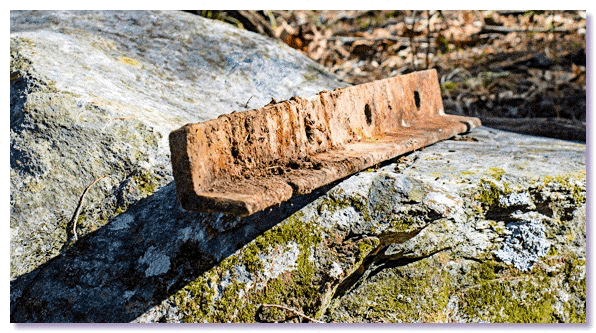
Railroad track hardware found near an abandoned quarry at Variety Mills, Va.
Investigating the old Standard Soapstone railroad grade was a lot of fun. I discovered a lot of old industrial sites and remains of the old track.

Boiler foundation built from dry laid soapstone slabs at Variety Mills, Va.
But the nagging question remained; had any of this been narrow gauge? Had some of it been dual gauge? Which parts? Had the quarry branches been narrow and just the line to Norwood been standard?
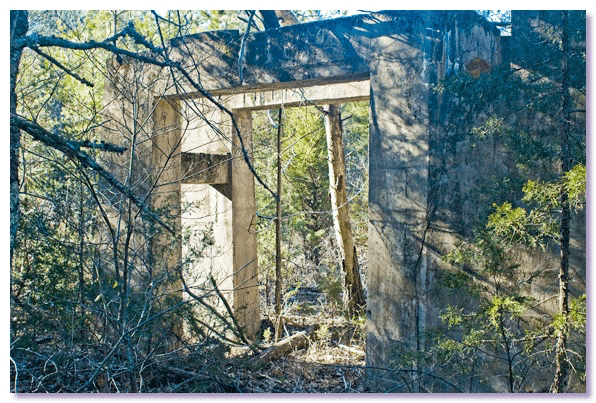
Concrete structure at boilerhouse site near Phoenix, Va.
What I needed was insight from a local resident. Someone with family ties to the Phoenix area who knew about the industrial history of the area.
My suspicions about the abandoned grade I was following through the woods from Norwood toward Rucker Run proved to be correct.

Soapstone Shortlines, Garth G. Groff
Garth Groff, a librarian at University of Virgina's Special Collections, self published a small booklet on the history of soapstone in Virginia. In it, he makes brief note of the fact that Phoenix Stone was purchased by Standard. Standard had built the railroad to Norwood, and that railroad was standard gauge.

Railroad track hardware found near an abandoned quarry at Variety Mills, Va.
Investigating the old Standard Soapstone railroad grade was a lot of fun. I discovered a lot of old industrial sites and remains of the old track.

Boiler foundation built from dry laid soapstone slabs at Variety Mills, Va.
But the nagging question remained; had any of this been narrow gauge? Had some of it been dual gauge? Which parts? Had the quarry branches been narrow and just the line to Norwood been standard?

Concrete structure at boilerhouse site near Phoenix, Va.
What I needed was insight from a local resident. Someone with family ties to the Phoenix area who knew about the industrial history of the area.
Narrow or not?
25/04/23 21:04
The beginning of this saga can be found here.

USGS Buckingham , 1968. Utility map "narrow gauge track" shown in red
The utility company map did not indicate that the narrow gauge railroad went to a connection with the Southern at Arrington, but to a connection with the Chesapeake & Ohio at Norwood.

Tye River and town of Norwood
Norwood is a very small, very old town at the confluence of the Tye and James Rivers.

Concrete abutments along abandoned railroad grade near Norwood
Driving north along the Tye River from Norwood I couldn't miss the substantial remains of an old railroad grade.
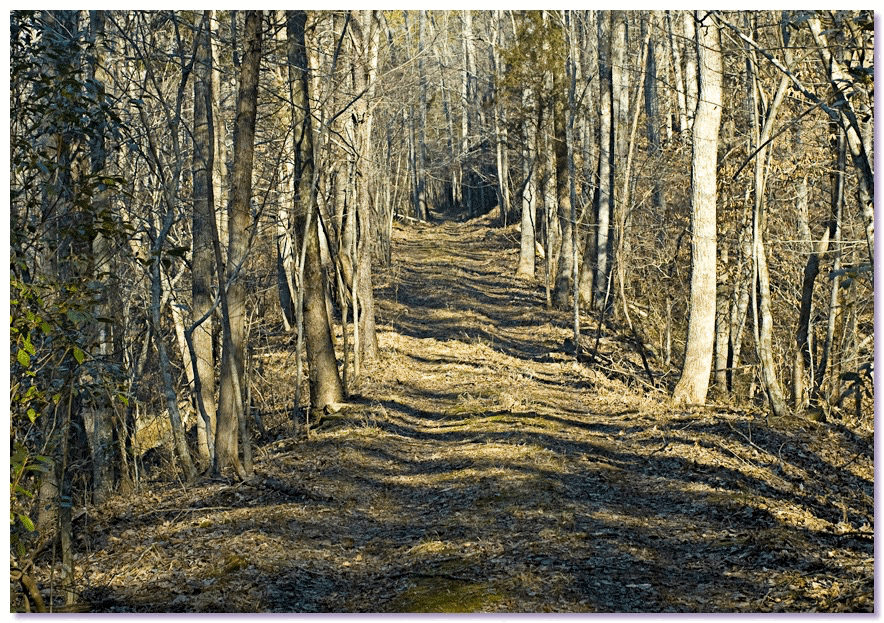
Abandoned grade through the woods along Rucker Run
Thanks to local hunters that kept the grade clear, it was relatively easy to follow. Hiking over high fills and through deep cuts, I began to have doubts.
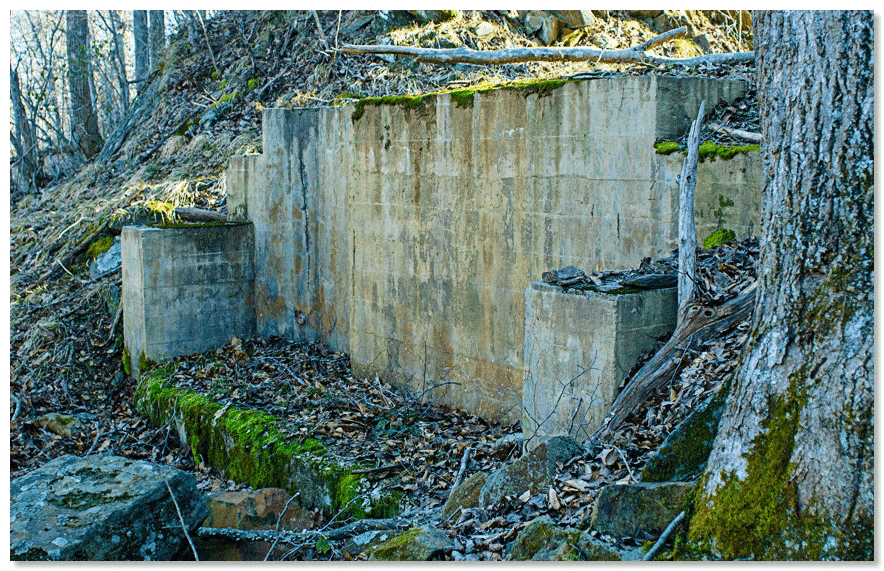
Abandoned soapstone railroad bridge abutment
The extensive grading and heavy concrete abutments impressed me as being too monumental to have been built for the sake of an industrial narrow gauge. This grade looked standard gauge to me.

USGS Buckingham , 1968. Utility map "narrow gauge track" shown in red
The utility company map did not indicate that the narrow gauge railroad went to a connection with the Southern at Arrington, but to a connection with the Chesapeake & Ohio at Norwood.

Tye River and town of Norwood
Norwood is a very small, very old town at the confluence of the Tye and James Rivers.

Concrete abutments along abandoned railroad grade near Norwood
Driving north along the Tye River from Norwood I couldn't miss the substantial remains of an old railroad grade.

Abandoned grade through the woods along Rucker Run
Thanks to local hunters that kept the grade clear, it was relatively easy to follow. Hiking over high fills and through deep cuts, I began to have doubts.

Abandoned soapstone railroad bridge abutment
The extensive grading and heavy concrete abutments impressed me as being too monumental to have been built for the sake of an industrial narrow gauge. This grade looked standard gauge to me.
A Map to Follow
28/03/23 14:16
The beginning of this saga can be found here.
USGS Buckingham 1892
My request for such a map from the Historical Society got me a detail of an old USGS quad showing Arrington and the general area of the old soapstone mill, but nothing connecting the two. I was not sure what I was supposed to learn from it other than the obvious fact that there is a mountain separating the town from the mill. The Historical Society may have meant the map to assure me the narrow gauge railroad was plausible because Arrington and the soapstone mill were not very far apart, but that mountain had the opposite effect on me, making the narrow gauge in fact seem less plausible.
I mentioned all this to a good friend of mine who works for the utility company that serves the Arrington area. He said the electric company had detailed maps of the utility easements for that area going back to the beginning of electrical service. Sometime later he handed over a pile of photocopies of old maps.

I worked my way down through the stack until I found one that showed a thin line marked ‘narrow gauge track’
Beyond old corporate records indicating Oliver Brothers had built a narrow gauge railroad, I wanted to see the old grade on a map.

USGS Buckingham 1892
My request for such a map from the Historical Society got me a detail of an old USGS quad showing Arrington and the general area of the old soapstone mill, but nothing connecting the two. I was not sure what I was supposed to learn from it other than the obvious fact that there is a mountain separating the town from the mill. The Historical Society may have meant the map to assure me the narrow gauge railroad was plausible because Arrington and the soapstone mill were not very far apart, but that mountain had the opposite effect on me, making the narrow gauge in fact seem less plausible.
I mentioned all this to a good friend of mine who works for the utility company that serves the Arrington area. He said the electric company had detailed maps of the utility easements for that area going back to the beginning of electrical service. Sometime later he handed over a pile of photocopies of old maps.

I worked my way down through the stack until I found one that showed a thin line marked ‘narrow gauge track’
More information, still no evidence
14/03/23 11:11
The beginning of this saga can be found here.
An inquiry to the Nelson County Historical Society asking whether there had actually been a narrow gauge soapstone railroad found its way to an attorney named Dick Whitehead who sent me copies of ancient DGMR reports on Phoenix Stone Company.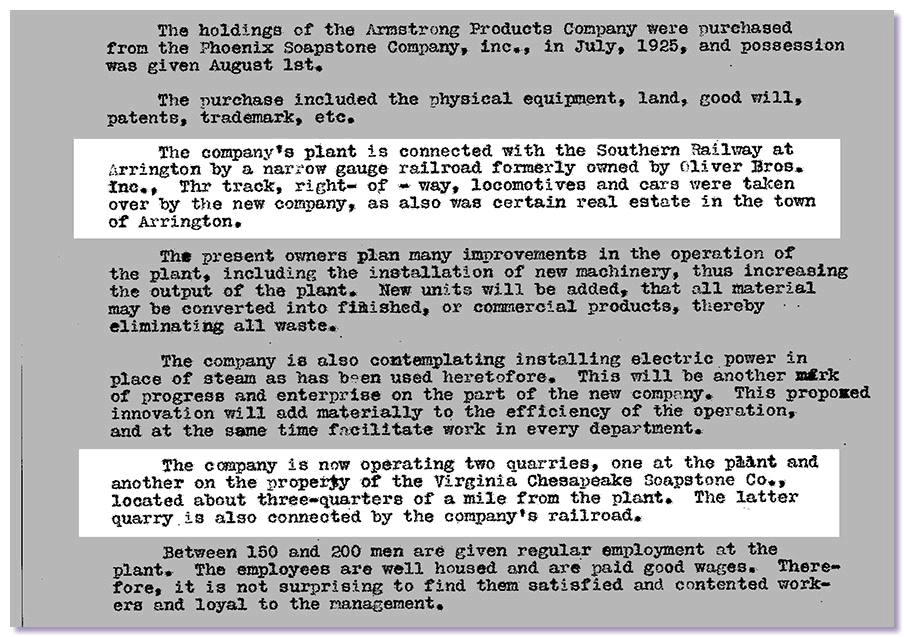
DGMR ECON FILE - STANDARD SOAPSTONE CORP ca1926
The Phoenix Stone report mentioned that the narrow gauge ran to Arrington. So I collected my maps, gassed up the truck and headed out to Arrington and again came up empty. I saw nothing there to suggest an abandoned railroad grade or transfer point.
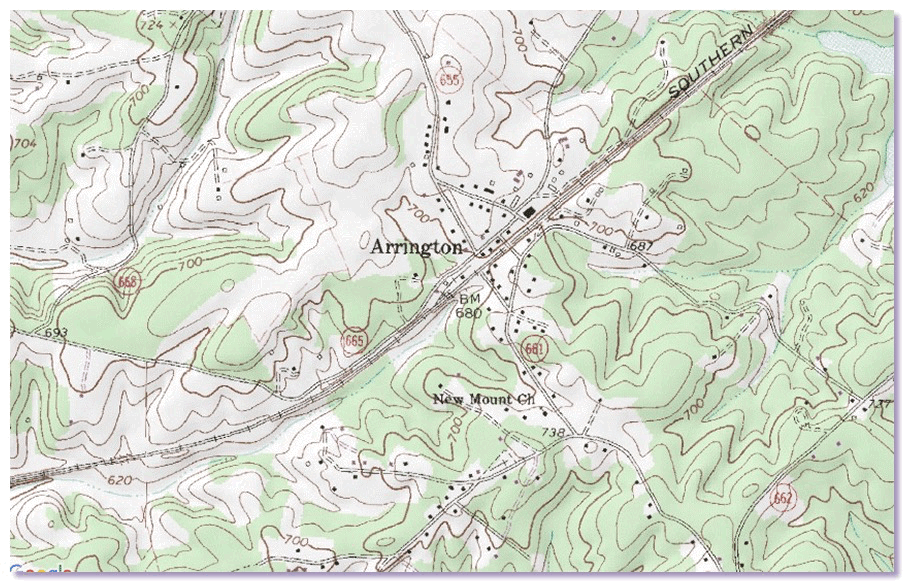
USGS Arrington quad
An inquiry to the Nelson County Historical Society asking whether there had actually been a narrow gauge soapstone railroad found its way to an attorney named Dick Whitehead who sent me copies of ancient DGMR reports on Phoenix Stone Company.

DGMR ECON FILE - STANDARD SOAPSTONE CORP ca1926
The Phoenix Stone report mentioned that the narrow gauge ran to Arrington. So I collected my maps, gassed up the truck and headed out to Arrington and again came up empty. I saw nothing there to suggest an abandoned railroad grade or transfer point.

USGS Arrington quad
Coming Up Empty
07/03/23 10:07
The beginning of this saga can be found here.
There are scant few published resources on the history of the soapstone industry in Virginia. Only a few of those make any mention of associated rail operations. Paul Saunder’s book Heartbeats of Nelson includes an interview with Robert Harlow, who was hired by Phoenix Stone Company to build dual gauge track at the site of a new mill under construction in 1925.
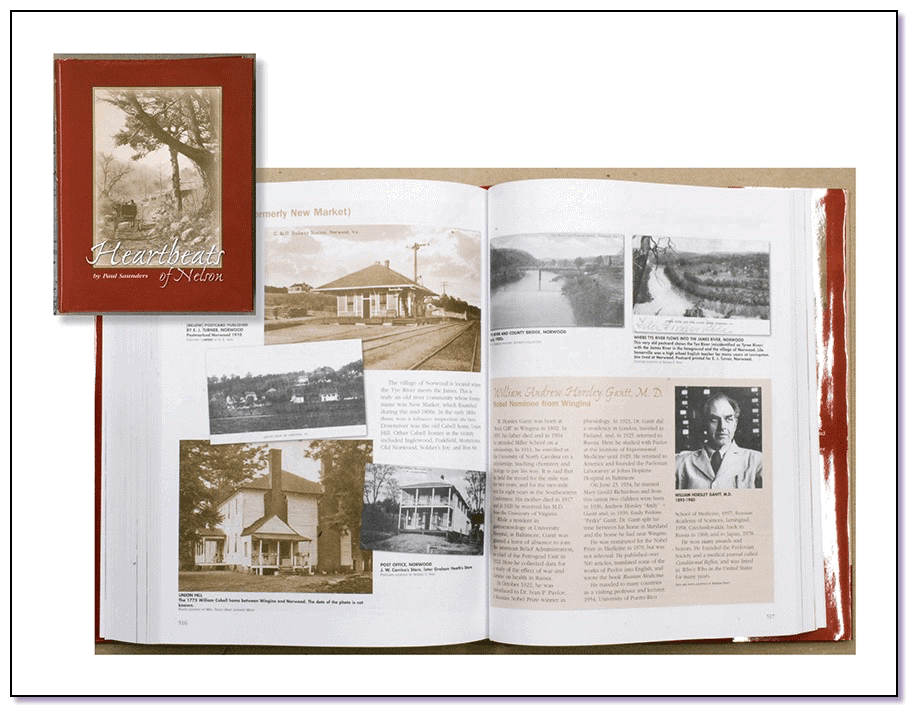
Heartbeats Of Nelson, Paul Saunders, 2007
Time for a road trip. I managed to find the remote crossroads where Phoenix Stone had been. I drove out there and found almost nothing. No quarries, no mill site, nothing that looked like an old railroad grade. Just thick woods, rusty mobile homes, and mean dogs.
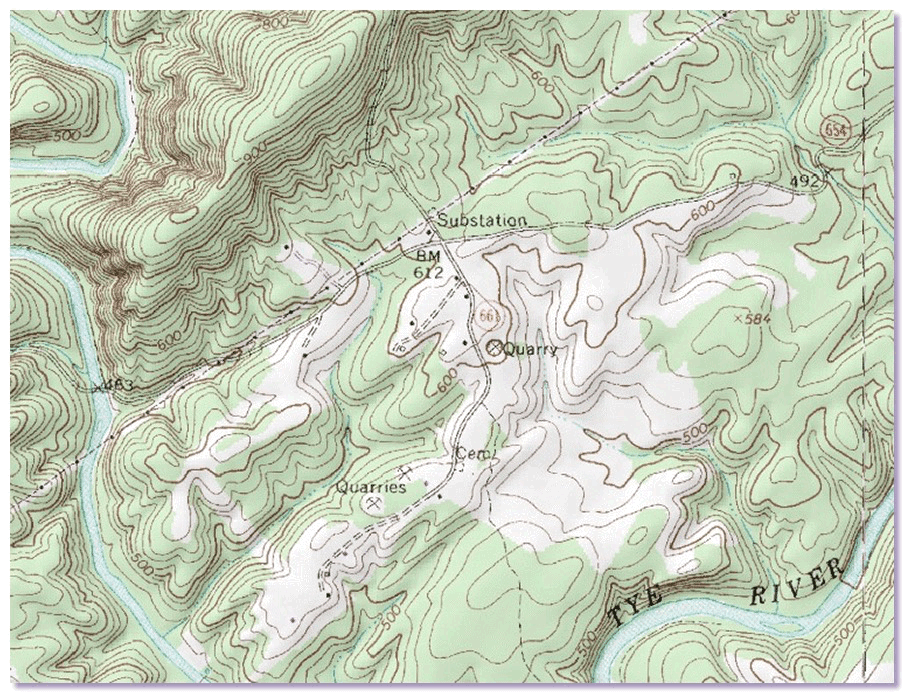
USGS Arrington quad
I wondered if there had been any narrow gauge industrial railroads associated with the old soapstone operations.
There are scant few published resources on the history of the soapstone industry in Virginia. Only a few of those make any mention of associated rail operations. Paul Saunder’s book Heartbeats of Nelson includes an interview with Robert Harlow, who was hired by Phoenix Stone Company to build dual gauge track at the site of a new mill under construction in 1925.

Heartbeats Of Nelson, Paul Saunders, 2007
Time for a road trip. I managed to find the remote crossroads where Phoenix Stone had been. I drove out there and found almost nothing. No quarries, no mill site, nothing that looked like an old railroad grade. Just thick woods, rusty mobile homes, and mean dogs.

USGS Arrington quad
Nelson & Albemarle Railway
21/12/21 07:05
The beginning of this saga can be found here.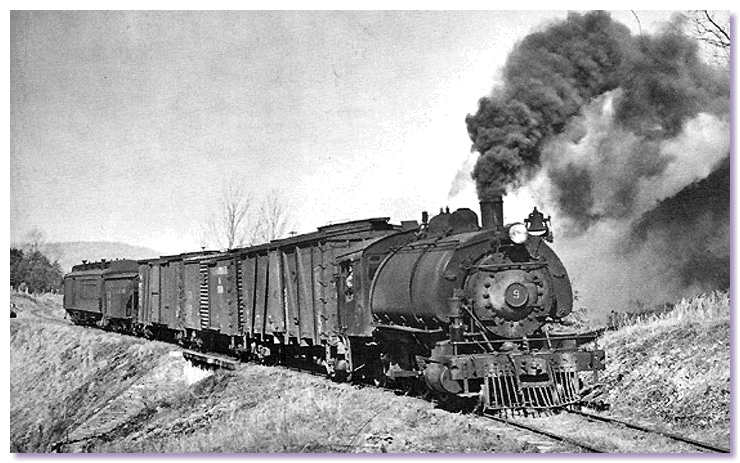
Charles Clegg photo - California Railroad Museum collection
The Nelson & Albemarle was a perfect complement to both the soapstone industry it served and the scenery through which it ran. Vulcan built saddle tank steam locomotives hauled short trains along a lightly graded right-of-way.
Alberene Stone Company and the N&A could certainly provide excellent inspiration for an On30 model railroad. But the N&A is standard gauge …
The Nelson & Albemarle Railway took a circuitous route between a connection with the Chesapeake & Ohio Railroad and the Southern, serving mills at Alberene and Schuyler as well as the soapstone quarries along the way.

Charles Clegg photo - California Railroad Museum collection
The Nelson & Albemarle was a perfect complement to both the soapstone industry it served and the scenery through which it ran. Vulcan built saddle tank steam locomotives hauled short trains along a lightly graded right-of-way.
Alberene Stone Company and the N&A could certainly provide excellent inspiration for an On30 model railroad. But the N&A is standard gauge …
Virginia-Alberene Stone Company
19/11/21 09:28
The beginning of this saga can be found here.
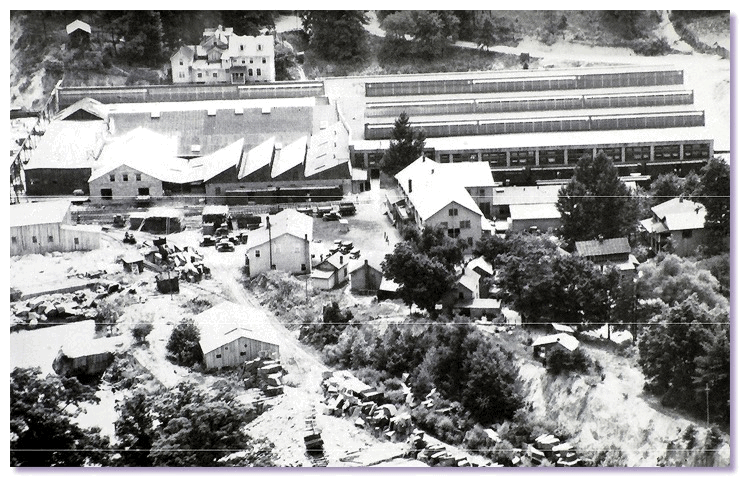
Kierk Ashmore-Sorensen collection
In the early 1900s, Alberene Stone Company had 100s of workers in the mill cutting, finishing, and assembling a variety of soapstone products.
One Company in particular was very successful manufacturing and marketing soapstone products.

Kierk Ashmore-Sorensen collection
In the early 1900s, Alberene Stone Company had 100s of workers in the mill cutting, finishing, and assembling a variety of soapstone products.
A Likely Candidate
30/10/21 20:17
The beginning of this saga can be found here.

Virginia Minerals newsletter, April 1961
One of only a few places in the world where the quality of the stone is high enough for architectural and dimensional applications.
As it happens, there is a unique and commercially viable stripe of soapstone deposits running right along the western Piedmont of central Virginia in the foothills of the Blue Ridge Mountains.

Virginia Minerals newsletter, April 1961
One of only a few places in the world where the quality of the stone is high enough for architectural and dimensional applications.
Compatible Industry
21/10/21 08:15
The idea of a complementary industry to the Blue Ridge foothills of Virginia had crossed H. Reid's mind.
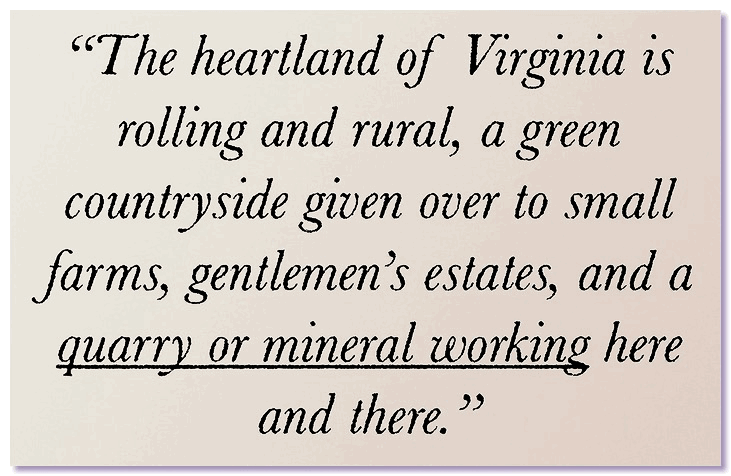
H. Reid - An Upcountry Romance
This quote from an old article that appeared in Steam Locomotives and Railroad Tradition magazine depicts quarry and mineral operations as being a good “fit” for the overall setting.
Looking for Inspiration
15/10/21 08:20
My autumn road trip routes take me up narrow creek valleys and through rolling countryside.

Wouldn’t it be cool if there had been an old, isolated industry around here that complemented the scale and nature of the scene, used old equipment, looked hand hewn and overgrown ...
Autumn in the Foothills
09/10/21 09:14
Autumn is my favorite season for driving the backroads of Nelson County.
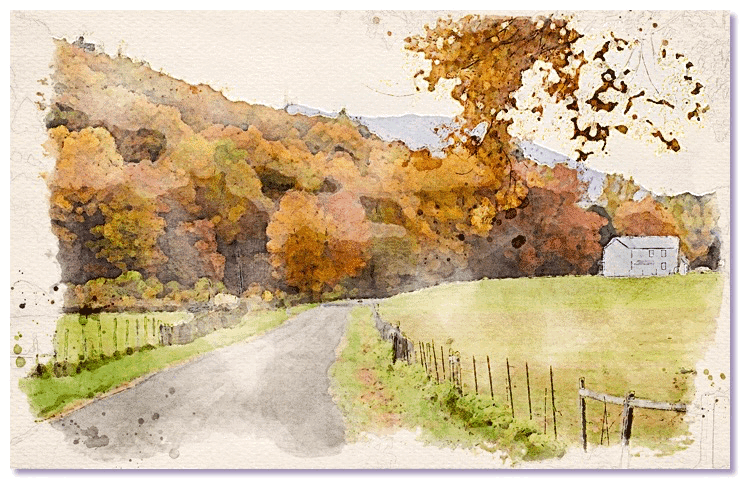
My road trips have evolved from mad dashes trying to see as much as possible to focused trips to one particular spot in order to spend enough time there to really "see" it. My favorite places tend to be near railroads or abandoned grades. When I come upon a particularly modelgenic scene, I speculate on the possiblity of the narrow country road being built on an old narrow gauge railroad grade.
Scenery Reference
11/12/18 11:05
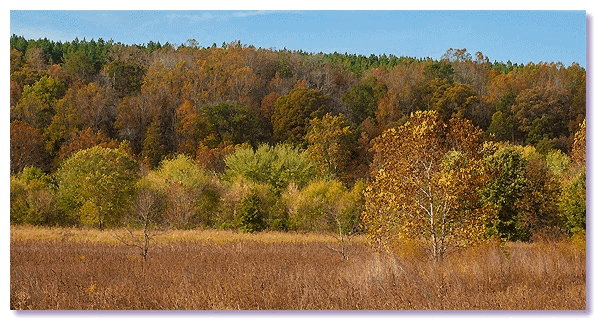
James River State Park
Bent Creek, VA
Reference for scenery color and texture.
Upcountry Romance
30/09/15 15:45
A Reminiscence in an old railfan publication - "An Upcountry Romance"

"The heartland of Virginia is rolling and rural, a green countryside given over to small farms, gentlemen's estates, and a quarry or mineral working here and there."
Tom Sullivan ran across an article about the Nelson & Albemarle Railroad by H. Reid in the May 1963 Steam Locomotive & Railroad Tradition magazine, and was kind enough to pass it on to me.
The article is illustrated by a cartoon created by H. Reid himself, portraying many events in the colloquial history of the line in one non-linear jumble of movie stars, rabbit hunts, escaped livestock, and smooches. An N&A train is shown traversing an apparent loop of track connecting Rockfish to Warren.
A rambling, florid story based on the facts but heavy on suppositional dialogue and local legends, the article brought two old impressions back into sharp focus for me. The first is that the N&A was a perfect compliment to the area through which it ran. The little locomotives hauled short trains on a lightly graded right-of-way through the woods and pastures of Piedmont. The mill that provided freight for the railroad was surrounded by a campus of beautiful, small stone buildings that looked transplanted from Cornwall or Wales.
The embellished history in the article also depicted the N&A as an excellent railroad to model. I could imagine that the article had actually been written about a model railroad, an illusion supported by the circular track plan illustrated in the cartoon. "An Upcountry Romance" describes an idealized inspiration for my own model railroad, making me want to develop a backstory that might serve as the text for a pictorial article for a hobby publication.

"The heartland of Virginia is rolling and rural, a green countryside given over to small farms, gentlemen's estates, and a quarry or mineral working here and there."
Tom Sullivan ran across an article about the Nelson & Albemarle Railroad by H. Reid in the May 1963 Steam Locomotive & Railroad Tradition magazine, and was kind enough to pass it on to me.
The article is illustrated by a cartoon created by H. Reid himself, portraying many events in the colloquial history of the line in one non-linear jumble of movie stars, rabbit hunts, escaped livestock, and smooches. An N&A train is shown traversing an apparent loop of track connecting Rockfish to Warren.
A rambling, florid story based on the facts but heavy on suppositional dialogue and local legends, the article brought two old impressions back into sharp focus for me. The first is that the N&A was a perfect compliment to the area through which it ran. The little locomotives hauled short trains on a lightly graded right-of-way through the woods and pastures of Piedmont. The mill that provided freight for the railroad was surrounded by a campus of beautiful, small stone buildings that looked transplanted from Cornwall or Wales.
The embellished history in the article also depicted the N&A as an excellent railroad to model. I could imagine that the article had actually been written about a model railroad, an illusion supported by the circular track plan illustrated in the cartoon. "An Upcountry Romance" describes an idealized inspiration for my own model railroad, making me want to develop a backstory that might serve as the text for a pictorial article for a hobby publication.
Wingina and Norwood
30/06/15 08:05
A scenic stretch of the James River with a long history - Norwood to Wingina
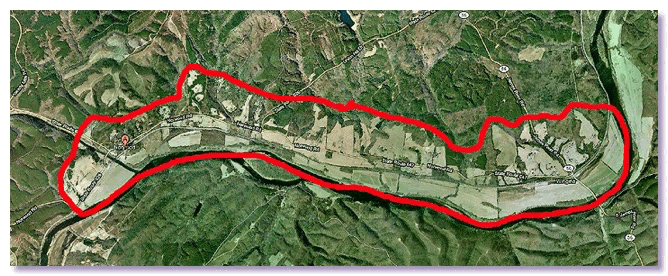
Area included in the survey
I recently attended a meeting of the Nelson County Historical Society held at St. John’s Baptist Church in Norwood. The program was a presentation of the Survey of Architectural Resources in the Norwood and Wingina Vicinities in Nelson County, Virginia.
This stretch of the James River along the southeastern border of Nelson County has long been one of my favorite trip destinations. The road connecting Norwood to Wingina is one of the few that closely parallels the river in the floodplain, offering a long, wide view of the bottomland, railroad, and the wooded bluffs of Buckingham County along the south side of the river. My impression of this area is what I hope to impart on the section of my model railroad that I call Winwood. The name of my fictional river town of Winwood is a contraction of “WINgina-norWOOD.
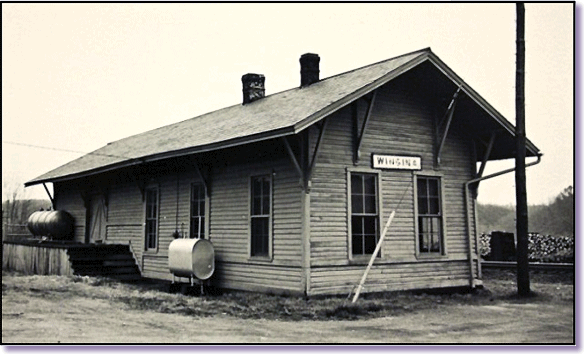
The old C&O depot in Wingina
While the entire length of the James River through the central Virginia Piedmont is full of historic mill sites, canal remains, and old farmhouses, I learned from the HistoryTech survey that Norwood and Wingina are the bookends of an area with an unusually high concentration of historically significant architecture, prompting the discussion of creating an Historic District.
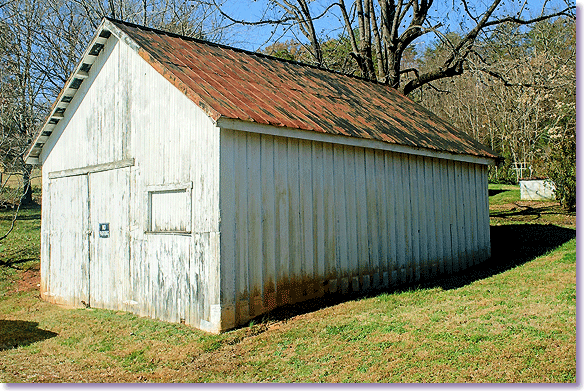
Norwood is a great source for small structure detail reference
I learned a great deal about the history of the area from attending the HistoryTech presentation. I also learned that one of my primary interests in the area is not considered very historically significant; there was no mention made of the standard gauge industrial railroad of the Standard Soapstone Company. The concrete abutments and bridge piers standing in a field just outside of town had always riveted my attention. Not everyone finds them as interesting as I do apparently.
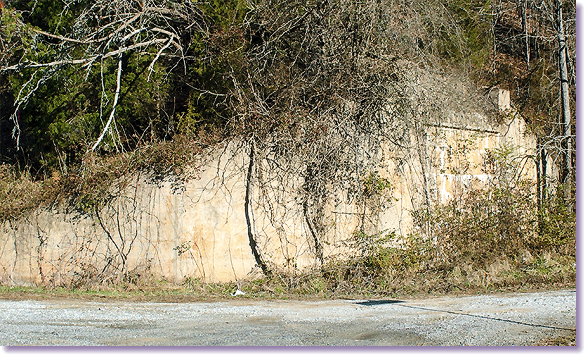
abandoned railroad bridge abutment at Norwood
Presentation at Schuyler
11/07/14 07:16
In a rather roundabout way, an opportunity came my way to participate in a meeting of the Nelson County Historical Society.
The subject of the meeting was to be the soapstone mill town of Schuyler, the location Schuyler Baptist Church. The folks responsible for finding speakers wanted a knowledgeable person to present a history of the Nelson & Albemarle Railroad. Their first choice was Rob Peters, and rightfully so. Rob has done a superb job of accumulating information about the N&A on his website, but at the time of the meeting, Rob was traveling and would not be able to make it.
With Rob unavailable, the next choice for a speaker on the history of the Nelson & Albemarle would be Garth Groff. Garth is a talented researcher and rail historian who is widely published, having written the definitive history of the N&A, Soapstone Shortlines. But Garth was not available the day of the meeting, as his historical interests have now extended beyond Nelson County to the castles of 15th Century Scotland. Garth is now very active in the Isenfir Shire of the Society for Creative Anachronism.
Going back to the bullpen for the third time, the Nelson County Historical Society finally got a commitment from me to give a presentation on the history of the N&A. I was thrilled at the prospect, but my schedule was tight for that weekend. Being in Schuyler for the meeting would mean getting on the road early that morning and heading east from Grayson County, where I attended the Wayne Henderson Festival the day before.
I don’t know a great deal about the history of the N&A, but I know enough to be able to put together a 20 minute Power Point presentation.
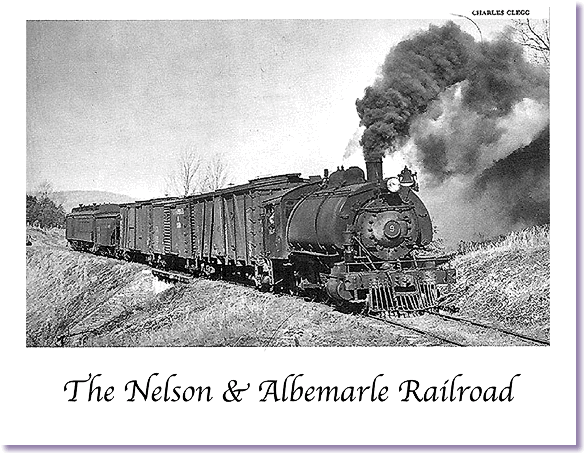
Meeting these relatively light requirements was all I needed to do in order to get a seat at the front. 80% of what I presented came directly from the sources of Rob Peters and Garth Groff. I appreciate the effort they have put into researching the Nelson & Albemarle Railroad and making their findings available.
The NCHS presented me with a copy of Mary Lyon’s book The Blue Ridge Tunnel.
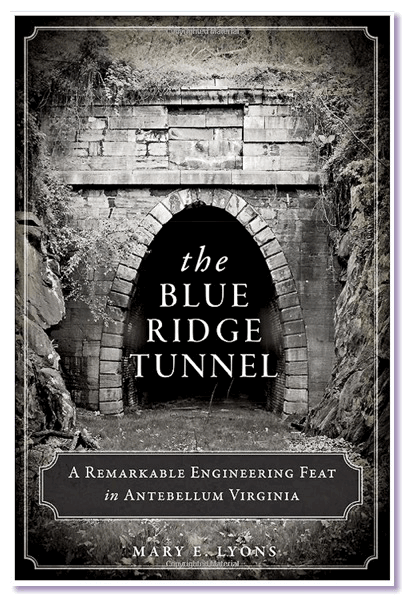
Along with this book, I left the meeting with pages of notes on the subjects covered by the other presenters. For many years I have driven to Schuyler and the surrounding area, fascinated by its rugged isolation, always being very self conscious about being an outsider catching brief glimpses of a unique town whose history and setting I found compelling enough to want to model. To be able to participate in a sanctioned discussion of the history of the town in the town itself was really a dream come true. Thanks to Dick Whitehead and the Nelson County Historical Society for the opportunity.
The subject of the meeting was to be the soapstone mill town of Schuyler, the location Schuyler Baptist Church. The folks responsible for finding speakers wanted a knowledgeable person to present a history of the Nelson & Albemarle Railroad. Their first choice was Rob Peters, and rightfully so. Rob has done a superb job of accumulating information about the N&A on his website, but at the time of the meeting, Rob was traveling and would not be able to make it.
With Rob unavailable, the next choice for a speaker on the history of the Nelson & Albemarle would be Garth Groff. Garth is a talented researcher and rail historian who is widely published, having written the definitive history of the N&A, Soapstone Shortlines. But Garth was not available the day of the meeting, as his historical interests have now extended beyond Nelson County to the castles of 15th Century Scotland. Garth is now very active in the Isenfir Shire of the Society for Creative Anachronism.
Going back to the bullpen for the third time, the Nelson County Historical Society finally got a commitment from me to give a presentation on the history of the N&A. I was thrilled at the prospect, but my schedule was tight for that weekend. Being in Schuyler for the meeting would mean getting on the road early that morning and heading east from Grayson County, where I attended the Wayne Henderson Festival the day before.
I don’t know a great deal about the history of the N&A, but I know enough to be able to put together a 20 minute Power Point presentation.

Meeting these relatively light requirements was all I needed to do in order to get a seat at the front. 80% of what I presented came directly from the sources of Rob Peters and Garth Groff. I appreciate the effort they have put into researching the Nelson & Albemarle Railroad and making their findings available.
The NCHS presented me with a copy of Mary Lyon’s book The Blue Ridge Tunnel.

Along with this book, I left the meeting with pages of notes on the subjects covered by the other presenters. For many years I have driven to Schuyler and the surrounding area, fascinated by its rugged isolation, always being very self conscious about being an outsider catching brief glimpses of a unique town whose history and setting I found compelling enough to want to model. To be able to participate in a sanctioned discussion of the history of the town in the town itself was really a dream come true. Thanks to Dick Whitehead and the Nelson County Historical Society for the opportunity.